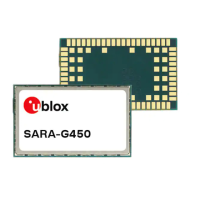SARA-G450 - System integration manual
UBX-18046432 - R08 Handling and soldering Page 119 of 143
C1-Public
3.3 Soldering
3.3.1 Soldering paste
Use of “No Clean” soldering paste is strongly recommended, as it does not require cleaning after the
soldering process has taken place. The paste listed in the example below meets these criteria.
Soldering Paste: OM338 SAC405 / Nr.143714 (Cookson Electronics)
Alloy specification: 95.5% Sn / 3.9% Ag / 0.6% Cu (95.5% Tin / 3.9% Silver / 0.6% Copper)
95.5% Sn / 4.0% Ag / 0.5% Cu (95.5% Tin / 4.0% Silver / 0.5% Copper)
Melting Temperature: 217 °C
Stencil Thickness: 150 µm for base boards
The final choice of the soldering paste depends on the approved manufacturing procedures.
The paste-mask geometry for applying soldering paste should meet the recommendations in section
2.11.
☞ The quality of the solder joints should meet the appropriate IPC specification.
3.3.2 Reflow soldering
A convection type-soldering oven is strongly recommended over the infrared type radiation oven.
Convection heated ovens allow precise control of the temperature and all parts will be heated up
evenly, regardless of the material properties, thickness of components and surface color.
Consider the “IPC-7530A Guidelines for temperature profiling for mass soldering (reflow and wave)
processes”.
Reflow profiles are to be selected according to the following recommendations.
⚠ Failure to observe these recommendations can result in severe damage to the device!
Preheat phase
Initial heating of component leads and balls. Residual humidity will be dried out. Note that this preheat
phase will not replace prior baking procedures.
Temperature rise rate: max 3 °C/s If the temperature rise is too rapid in the preheat phase,
it may cause excessive slumping.
Time: 60 to 120 s If the preheat is insufficient, rather large solder balls tend to be generated.
Conversely, if performed excessively, fine balls and large balls will be generated in clusters.
End Temperature: 150 to 200 °C If the temperature is too low, non-melting tends to be caused in
areas containing large heat capacity.
Heating/reflow phase
The temperature rises above the liquidus temperature of 217 °C. Avoid a sudden rise in temperature
as the slump of the paste could become worse.
Limit time above 217 °C liquidus temperature: 40 to 60 s
Peak reflow temperature: 245 °C

